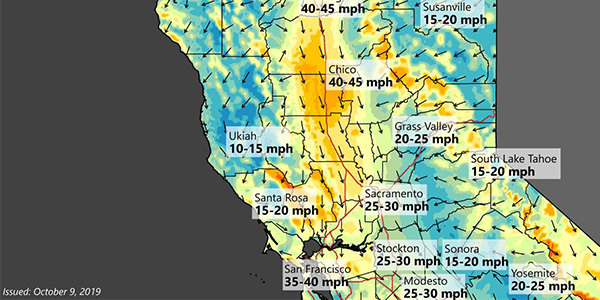By Hudson Sangree
SACRAMENTO, Calif. — The federal judge overseeing PG&E’s mammoth bankruptcy opened the door to a competing takeover plan Wednesday, potentially allowing a group of bondholders to seize control of California’s largest utility from its current investor owners.
The move to end PG&E’s exclusivity period — the time it has to offer its own Chapter 11 plan unopposed — occurred as all eyes were fixed on PG&E’s decision to shutoff power Wednesday to at least 513,000 Northern California customers in an effort to prevent the type of deadly fires that drove it to seek bankruptcy protection in January.
“[PG&E’s reorganization] plan is on track as well as can be expected for now,” U.S. Bankruptcy Court Judge Montali wrote in his order ending exclusivity. “That said, the parties most deserving of consideration [the fire victims], speaking through the [Official Committee of Tort Claimants] have changed their position from the last time the court considered terminating exclusivity, and spoken loudly and clearly that they want their and the Senior Noteholders’ proposed plan to be considered.”
“The coming weeks will permit ample time to explore and resolve issues regarding both plans consistent with the more traditional plan vetting processes well-known by bankruptcy professionals,” Montali wrote.
The judge instructed the bondholders to file their plan by Oct. 17. In its preliminary form, the bondholders’ plan proposed investing more than $29 billion in PG&E in exchange for a controlling interest in the utility. It includes a provision for paying wildfire claimants about $13.5 billion, insurance companies $11 billion and local governments $1 billion.
As Montali filed his order, PG&E had come under intense scrutiny for its decision to shut down power to large swaths of its Northern California service territory, citing gusty winds that could cause utility-sparked conflagrations like those of the past two fall fire seasons.
The unprecedented public safety power shutoffs (PSPS) — affecting as many as 800,000 customers and millions of residents in 34 counties — were by far the largest yet in a state struggling to protect its residents from fires that have turned dramatically more deadly and destructive in recent years.
PG&E faces billions of dollars in potential liabilities for the North Bay (or wine country) fires of early October 2017 and the Camp Fire of November 2018, which combined killed nearly 120 people and destroyed tens of thousands of homes. Those fires started in weather conditions similar to Wednesday’s. (See related story, Fearing Wildfires, PG&E to Cut Power to 800,000.)
“The safety of our customers and the communities we serve is our most important responsibility, which is why PG&E has decided to turn power off to customers during this widespread, severe wind event,” Michael Lewis, vice president of PG&E electric operations, said in a statement. “We understand the effects this event will have on our customers and appreciate the public’s patience as we do what is necessary to keep our communities safe and reduce the risk of wildfire.”
The utility said its decision to turn off power was based on “forecasts of dry, hot and windy weather including potential fire risk. Based on the latest weather forecasts and models, PG&E anticipates that this weather event will last through midday Thursday, with peak winds forecasted from Wednesday morning through Thursday morning and reaching 60 to 70 mph at higher elevations.”
Afterward, PG&E crews must inspect lines to make sure it’s safe to restore power, meaning the outage could last into the weekend.
Soon after midnight Wednesday, PG&E began its intentional blackout of approximately 513,000 customers in the Sierra Nevada foothills east of Sacramento, on the state’s North Coast and in the mountainous landscape north of San Francisco. The first phase of its planned three-phase outage was completed about 4 a.m.
PG&E said it would turn out the lights for 234,000 more customers in the San Francisco Bay Area and elsewhere at midday on Wednesday, though it postponed that move for at least several hours. It said it was considering shutting down power to around 42,000 customers in the far southern part of its service area, where it abuts the area served by the state’s second largest investor-owned utility, Southern California Edison.
SCE said it was weighing shutting down transmission and distribution lines that serve nearly 174,000 customers Wednesday, but it had not done so as of 3 p.m. PT.
The winds that spread wildfires each fall in California are known as Santa Ana winds in the south and Diablo winds in the north. They fan blazes in vegetation dried out by the long rainless months of the state’s Mediterranean climate.
Winds blew at 10 to 45 mph from the north and east in PG&E’s territory, the National Weather Service reported Wednesday as it issued a red-flag warning. Gusts tend to blow hardest across Northern California’s ridgetops, whipping wildfires into fast-moving firestorms that are nearly impossible for firefighters to control.
San Diego Gas & Electric began shutting down power proactively after a series of massive fires there last decade. SCE followed, as did PG&E starting last year. It considered shutting down power to the area scorched by the Camp Fire, which destroyed the town of Paradise and killed 86 people, but opted not to. (See Fire Season Starts in Calif. with Power Shutoffs.)
Typical PSPS events have generally affected anywhere from a handful of customers to more than 5,000, according to records kept by the California Public Utilities Commission starting in 2013. PG&E upped the ante when it shut down power to 48,000 customers in late September, but this weeks’ events dwarf that number.
CAISO said it did not expect “any impact to the bulk electric system for the duration of this event.”



